Effects of Potential Large-Scale Irrigation on Regional Precipitation in Northwest China
Abstract
:1. Introduction
2. Model Description and Experimental Design
2.1. Study Area
2.2. Model Description and Irrigation Scheme Implementation
2.3. Data Resources
2.4. Experimental Design
2.5. Extreme Precipitation Indices
2.6. Distribution Functions Selected
2.7. Moist Static Energy Analysis
3. Results
3.1. Performance of RegCM4 on Precipitation Climatology
3.2. Impact of Climate Change on Precipitation Climatology
3.3. Influence of Irrigation on the Spatiotemporal Characteristics of Precipitation
4. Discussion
4.1. Impact of Irrigation on Precipitation Types and Its Driving Mechanisms
4.2. Limitations and Uncertainties
5. Conclusions
Supplementary Materials
Author Contributions
Funding
Data Availability Statement
Acknowledgments
Conflicts of Interest
References
- Konikow, L.-F.; Kendy, E. Groundwater depletion: A global problem. Hydrogeol. J. 2005, 1, 317–320. [Google Scholar] [CrossRef]
- Shah, T.; Roy, A.-D.; Qureshi, A.-S.; Wang, J. Sustaining Asia’s groundwater boom: An overview of issues and evidence. Nat. Resour. Forum 2003, 2, 130–141. [Google Scholar] [CrossRef]
- Zhuang, W. Eco-environmental impact of inter-basin water transfer projects: A review. Environ. Sci. Pollut. Res. 2016, 13, 12867–12879. [Google Scholar] [CrossRef]
- DeAngelis, A.; Dominguez, F.; Fan, Y.; Robock, A.; Kustu, M.-D.; Robinson, D. Evidence of enhanced precipitation due to irrigation over the Great Plains of the United States. J. Geophys. Res. Atmos. 2010, 115, D15115. [Google Scholar] [CrossRef]
- Harding, K.-J.; Snyder, P.-K. Modeling the atmospheric response to irrigation in the Great Plains. Part II: The precipitation of irrigated water and changes in precipitation recycling. J. Hydrometeorol. 2012, 6, 1687–1703. [Google Scholar] [CrossRef]
- Kueppers, L.-M.; Snyder, M.-A.; Sloan, L.-C. Irrigation cooling effect: Regional climate forcing by land-use change. Geophys. Res. Lett. 2007, 34, L3703. [Google Scholar] [CrossRef]
- Qian, Y.; Huang, M.-Y.; Yang, B.; Berg, L.-K. A Modeling Study of Irrigation Effects on Surface Fluxes and Land–Air–Cloud Interactions in the Southern Great Plains. J. Hydrometeorol. 2013, 3, 700–721. [Google Scholar] [CrossRef]
- Saeed, F.; Hagemann, S.; Jacob, D. Impact of irrigation on the South Asian summer monsoon. Geophys. Res. Lett. 2009, 20, 1437–1454. [Google Scholar] [CrossRef]
- Zou, J.; Xie, Z.-H.; Yu, Y.; Zhan, C.-S.; Sun, Q. Climatic responses to anthropogenic groundwater exploitation: A case study of the Haihe River Basin, Northern China. Clim. Dyn. 2014, 42, 2125–2145. [Google Scholar] [CrossRef]
- Niyogi, D.; Kishtawal, C.; Tripathi, S.; Govindaraju, R.-S. Observational evidence that agricultural intensification and land use change may be reducing the Indian summer monsoon rainfall. Water Resour. Res. 2010, 46, W3533. [Google Scholar] [CrossRef]
- Lobell, D.-B.; Bonfils, C.-J.; Kueppers, L.-M.; Snyder, M.-A. Irrigation cooling effect on temperature and heat index extremes. Geophys. Res. Lett. 2008, 35, L9705. [Google Scholar] [CrossRef]
- Boucher, O.; Myhre, G.; Myhre, A. Direct human influence of irrigation on atmospheric water vapour and climate. Clim. Dyn. 2004, 6, 597–603. [Google Scholar] [CrossRef]
- Sorooshian, S.; Li, J.-L.; Hsu, K.-L.; Gao, X.-G. Influence of irrigation schemes used in regional climate models on evapotranspiration estimation: Results and comparative studies from California’s Central Valley agricultural regions. J. Geophys. Res. Atmos. 2012, 117, D6107. [Google Scholar] [CrossRef]
- Kueppers, L.-M.; Snyder, M.-A.; Sloan, L.-C.; Cayan, D.; Jin, J.; Kanamaru, H.; Kanamitsu, M.; Miller, N.-L.; Tyree, M.; Du, H.; et al. Seasonal temperature responses to land-use change in the western United States. Glob. Planet. Chang. 2008, 3, 250–264. [Google Scholar] [CrossRef]
- Yang, Z.; Dominguez, F.; Zeng, X.-B.; Hu, H.-C.; Gupta, H.; Yang, B. Impact of irrigation over the California Central Valley on regional climate. J. Hydrometeorol. 2017, 5, 1341–1357. [Google Scholar] [CrossRef]
- Zeng, Y.-J.; Xie, Z.-H.; Liu, S. Seasonal effects of irrigation on land–atmosphere latent heat, sensible heat, and carbon fluxes in semiarid basin. Earth Syst. Dyn. 2017, 1, 113–127. [Google Scholar] [CrossRef]
- Pei, L.-S.; Moore, N.; Zhong, S.-Y.; Kendall, A.-D.; Gao, Z.-Q.; Hyndman, D.-W. Effects of Irrigation on Summer Precipitation over the United States. J. Clim. 2016, 10, 3541–3558. [Google Scholar] [CrossRef]
- Yang, Z.; Qian, Y.; Liu, Y.; Berg, L.-K.; Gustafson, W.-I.; Feng, Z.; Sakaguchi, K.; Fast, J.-D.; Tai, S.; Yang, B.; et al. Understanding irrigation impacts on low-level jets over the Great Plains. Clim. Dyn. 2020, 55, 925–943. [Google Scholar] [CrossRef]
- Wang, X.-M.; Dong, Z.-B.; Zhang, J.-W.; Liu, L.-C. Modern dust storms in China: An overview. J. Arid. Environ. 2004, 4, 559–574. [Google Scholar] [CrossRef]
- Deng, M.-J. “Three Water Lines” strategy: Its spatial patterns and effects on water resources allocation in northwest China. Acta Geogr. Sin. 2018, 73, 1189–1203. [Google Scholar]
- Zhang, H. Discussion on water resources development and utilization of Tibet. Water Resour. Plan. Des. 2011, 1, 1–4. [Google Scholar]
- Wang, T.-Y.; Wang, Z.-H.; Guo, L.; Zhang, J.-Z.; Li, W.-H.; He, H.-J.; Zong, R.; Wang, D.-W.; Jia, Z.-C.; Wen, Y. Experiences and challenges of agricultural development in an artificial oasis: A review. Agric. Syst. 2021, 193, 103220. [Google Scholar] [CrossRef]
- Cai, P.; Hamdi, R.; Luo, G.; He, H.; Zhang, M.; Termonia, P.; De Maeyer, P. Agriculture intensification increases summer precipitation in Tianshan Mountains, China. Atmos. Res. 2019, 227, 140–146. [Google Scholar] [CrossRef]
- Yang, Z.; Qian, Y.; Liu, Y.; Berg, L.-K.; Hu, H.-C.; Dominguez, F.; Yang, B.; Feng, Z.; Gustafson, W.-I., Jr.; Huang, M.-Y.; et al. Irrigation Impact on Water and Energy Cycle During Dry Years Over the United States Using Convection-Permitting WRF and a Dynamical Recycling Model. J. Geophys. Res. Atmos. 2019, 21, 11220–11241. [Google Scholar] [CrossRef]
- Zhang, M.; Luo, G.; Cao, X.; Hamdi, R.; Li, T.; Cai, P.; Ye, H.; He, H. Numerical simulation of the irrigation effects on surface fluxes and local climate in typical mountain-oasis-desert systems in the Central Asia arid area. J. Geophys. Res. Atmos. 2019, 23, 12485–12506. [Google Scholar] [CrossRef]
- Li, J.; Wang, J. Regional cli mate effects of large-scale agricultural irrigation related to South-to-North Water Transfer Project in China. Adv. Water Sci. 2009, 3, 343–349. [Google Scholar]
- Zou, J.; Zhan, C.-S.; Xie, Z.-H.; Qin, P.-H.; Jiang, S.-S. Climatic impacts of the Middle Route of the South-to-North Water Transfer Project over the Haihe River basin in North China simulated by a regional climate model. J. Geophys. Res. Atmos. 2016, 15, 8983–8999. [Google Scholar] [CrossRef]
- Gao, Y.; Chen, Y.; Lv, S. Numerical Simulation of Different Irrigation Scheduling on Oasis in Northwest China. Prog. Geogr. 2004, 23, 38–50. [Google Scholar]
- Han, C.-Y.; Zhang, B.-Z.; Han, S.-J. Quantitative effects of changes in agricultural irrigation on potential evaporation. Hydrol. Process. 2021, 2, e14057. [Google Scholar] [CrossRef]
- Han, S.-J.; Yang, Z.-Y. Cooling effect of agricultural irrigation over Xinjiang, Northwest China from 1959 to 2006. Environ. Res. Lett. 2013, 8, 24039. [Google Scholar] [CrossRef]
- Wen, L.-J.; Jin, J.-M. Modelling and analysis of the impact of irrigation on local arid climate over northwest China. Hydrol. Process. 2012, 3, 445–453. [Google Scholar] [CrossRef]
- Zhang, X.-Z.; Xiong, Z.; Tang, Q.-H. Modeled effects of irrigation on surface climate in the Heihe River Basin, Northwest China. J. Geophys. Res. Atmos. 2017, 15, 7881–7895. [Google Scholar] [CrossRef]
- Zhao, Y.; Fang, Y.-J.; Cui, C.-X.; Huang, A.-N. Effects of irrigation on precipitation in the arid regions of Xinjiang, China. J. Arid. Land 2012, 2, 132–139. [Google Scholar] [CrossRef]
- Zhao, Y.; Huang, Y.; Wang, H.; Xiao, W.; Wang, H. Study on regional climate effect under water diversion in Northwest China. J. Hydraul. Eng. 2022, 3, 270–283+295. [Google Scholar]
- Meng, X.-Y.; Wang, H.; Wu, Y.-P.; Long, A.-H.; Wang, J.-H.; Shi, C.-X.; Ji, X.-N. Investigating spatiotemporal changes of the land-surface processes in Xinjiang using high-resolution CLM3.5 and CLDAS: Soil temperature. Sci. Rep. 2017, 7, 13286. [Google Scholar] [CrossRef] [PubMed]
- Giorgi, F.; Coppola, E.; Solmon, F.; Mariotti, L.; Sylla, M.; Bi, X.; Elguindi, N.; Diro, G.; Nair, V.; Giuliani, G. RegCM4: Model description and preliminary tests over multiple CORDEX domains. Clim. Res. 2012, 52, 7–29. [Google Scholar] [CrossRef]
- Giorgi, F.; Anyah, R.-O. The road towards RegCM4. Clim. Res. 2012, 52, 3–6. [Google Scholar] [CrossRef]
- Giorgi, F.; Jones, C.; Asrar, G.-R. Addressing climate information needs at the regional level: The CORDEX framework. World Meteorol. Organ. Bull. 2009, 3, 175–183. [Google Scholar]
- Gao, X.-J.; Ying, S.; Giorgi, F. Comparison of convective parameterizations in RegCM4 experiments over China with CLM as the land surface model. Atmos. Ocean. Sci. Lett. 2016, 4, 246–254. [Google Scholar] [CrossRef]
- Gao, X.-J.; Shi, Y.; Han, Z.-Y.; Wang, M.-L.; Wu, J.; Zhang, D.-F.; Xu, Y.; Giorgi, F. Performance of RegCM4 over Major River Basins in China. Adv. Atmos. Sci. 2017, 4, 441–455. [Google Scholar] [CrossRef]
- van Vuuren, D.-P.; Edmonds, J.; Kainuma, M.; Riahi, K.; Thomson, A.; Hibbard, K.; Hurtt, G.-C.; Kram, T.; Krey, V.; Lamarque, J.-F.; et al. The representative concentration pathways: An overview. Clim. Chang. 2011, 109, 5–31. [Google Scholar] [CrossRef]
- Zhang, D.; Gao, X. Climate change of the 21st century over China from the ensemble of RegCM4 simulations. Chin. Sci. Bull. 2020, 23, 2516–2526. [Google Scholar] [CrossRef]
- Marsland, S.-J.; Haak, H.; Jungclaus, J.-H.; Latif, M.; Röske, F. The Max-Planck-Institute global ocean/sea ice model with orthogonal curvilinear coordinates. Ocean Model. 2003, 2, 91–127. [Google Scholar] [CrossRef]
- Dee, D.-P.; Uppala, S.-M.; Simmons, A.-J.; Berrisford, P.; Poli, P.; Kobayashi, S.; Andrae, U.; Balmaseda, M.-A.; Balsamo, G.; Bauer, P. The ERA-Interim reanalysis: Configuration and performance of the data assimilation system. Q. J. R. Meteorol. Soc. 2011, 656, 553–597. [Google Scholar] [CrossRef]
- Wu, J.; Gao, X.-J. A gridded daily observation dataset over China region and comparison with the other datasets. Chin. J. Geophys. 2013, 56, 1102–1111. [Google Scholar]
- Shi, Y.; Wang, G.-L.; Gao, X.-J. Role of resolution in regional climate change projections over China. Clim. Dyn. 2018, 51, 2375–2396. [Google Scholar] [CrossRef]
- Croitoru, A.; Chiotoroiu, B.; Ivanova Todorova, V.; Torică, V. Changes in precipitation extremes on the Black Sea Western Coast. Glob. Planet. Chang. 2013, 102, 10–19. [Google Scholar] [CrossRef]
- Alexander, L.-V.; Zhang, X.; Peterson, T.-C.; Caesar, J.; Gleason, B.; Klein Tank, A.-M.-G.; Haylock, M.; Collins, D.; Trewin, B.; Rahimzadeh, F.; et al. Global observed changes in daily climate extremes of temperature and precipitation. J. Geophys. Res. Atmos. 2006, 111, D5109. [Google Scholar] [CrossRef]
- Sun, W.-Y.; Mu, X.-M.; Song, X.-Y.; Wu, D.; Cheng, A.-F.; Qiu, B. Changes in extreme temperature and precipitation events in the Loess Plateau (China) during 1960–2013 under global warming. Atmos. Res. 2016, 168, 33–48. [Google Scholar] [CrossRef]
- You, Q.; Kang, S.; Aguilar, E.; Pepin, N.; Flügel, W.; Yan, Y.; Xu, Y.; Zhang, Y.; Huang, J. Changes in daily climate extremes in China and their connection to the large scale atmospheric circulation during 1961–2003. Clim. Dyn. 2011, 11, 2399–2417. [Google Scholar] [CrossRef]
- Chen, Y.-D.; Zhang, Q.; Xiao, M.-Z.; Singh, V.-P.; Leung, Y.; Jiang, L.-G. Precipitation extremes in the Yangtze River Basin, China: Regional frequency and spatial–temporal patterns. Theor. Appl. Climatol. 2014, 3, 447–461. [Google Scholar] [CrossRef]
- Liang, L.; Zhao, L.-N.; Gong, Y.-F.; Tian, F.-Y.; Wang, Z. Probability distribution of summer daily precipitation in the Huaihe basin of China based on Gamma distribution. Acta Meteorol. Sin. 2012, 26, 72–84. [Google Scholar] [CrossRef]
- Shin, J.; Lee, T.; Park, T.; Kim, S. Bias correction of RCM outputs using mixture distributions under multiple extreme weather influences. Theor. Appl. Climatol. 2019, 137, 201–216. [Google Scholar] [CrossRef]
- Yang, T.; Shao, Q.-X.; Hao, Z.-C.; Chen, X.; Zhang, Z.-X.; Xu, C.-Y.; Sun, L.-M. Regional frequency analysis and spatio-temporal pattern characterization of rainfall extremes in the Pearl River Basin, China. J. Hydrol. 2010, 3, 386–405. [Google Scholar] [CrossRef]
- Hosking, J.; Wallis, J. Regional Frequency Analysis: An Approach Based on L-Moments; Cambridge University Press: Cambridge, UK, 1997. [Google Scholar]
- Hannah, W.-M.; Maloney, E.-D. The Role of Moisture–Convection Feedbacks in Simulating the Madden–Julian Oscillation. J. Clim. 2011, 11, 2754–2770. [Google Scholar] [CrossRef]
- Hohenegger, C.; Brockhaus, P.; Bretherton, C.-S.; Schär, C. The Soil Moisture–Precipitation Feedback in Simulations with Explicit and Parameterized Convection. J. Clim. 2009, 19, 5003–5020. [Google Scholar] [CrossRef]
- Holloway, C.-E.; Wing, A.-A.; Bony, S.; Muller, C.; Masunaga, H.; L’Ecuyer, T.-S.; Turner, D.-D.; Zuidema, P. Observing Convective Aggregation. Surv. Geophys. 2017, 6, 1199–1236. [Google Scholar] [CrossRef]
- Oh, S.-G.; Suh, M.-S. Changes in seasonal and diurnal precipitation types during summer over South Korea in the late twenty-first century (2081–2100) projected by the RegCM4.0 based on four RCP scenarios. Clim. Dyn. 2018, 51, 3041–3060. [Google Scholar] [CrossRef]
- Zeng, Y.; Milly, P.-C.-D.; Shevliakova, E.; Malyshev, S.; van Huijgevoort, M.-H.-J.; Dunne, K.-A. Possible Anthropogenic Enhancement of Precipitation in the Sahel-Sudan Savanna by Remote Agricultural Irrigation. Geophys. Res. Lett. 2022, 6, e2021GL096972. [Google Scholar] [CrossRef]
- Wei, J.-F.; Dirmeyer, P.-A.; Wisser, D.; Bosilovich, M.-G.; Mocko, D.-M. Where Does the Irrigation Water Go? An Estimate of the Contribution of Irrigation to Precipitation Using MERRA. J. Hydrometeorol. 2013, 14, 275–289. [Google Scholar] [CrossRef]
- Im, E.; Marcella, M.-P.; Eltahir, E.-A.-B. Impact of Potential Large-Scale Irrigation on the West African Monsoon and Its Dependence on Location of Irrigated Area. J. Clim. 2014, 3, 994–1009. [Google Scholar] [CrossRef]
- Wu, Y.-P.; Shen, Y.-P.; Larry Li, B. Possible physical mechanism of water vapor transport over Tarim River Basin. Ecol. Complex. 2012, 9, 63–70. [Google Scholar] [CrossRef]
- Gao, X.-J.; Shi, Y.; Song, R.; Giorgi, F.; Wang, Y.; Zhang, D.-F. Reduction of future monsoon precipitation over China: Comparison between a high resolution RCM simulation and the driving GCM. Meteorol. Atmos. Phys. 2008, 100, 73–86. [Google Scholar] [CrossRef]
- Gu, C.; Huang, A.; Zhang, Y.; Yang, B.; Cai, S.; Xu, X.; Luo, J.; Wu, Y. The Wet Bias of RegCM4 Over Tibet Plateau in Summer Reduced by Adopting the 3D Sub-Grid Terrain Solar Radiative Effect Parameterization Scheme. J. Geophys. Res. Atmos. 2022, 21, e2022JD037434. [Google Scholar] [CrossRef]
- Li, B.-F.; Chen, Y.-N.; Chen, Z.-S.; Xiong, H.-G.; Lian, L.-S. Why does precipitation in northwest China show a significant increasing trend from 1960 to 2010? Atmos. Res. 2016, 167, 275–284. [Google Scholar] [CrossRef]
- Peng, D.-D.; Zhou, T.-J. Why was the arid and semiarid northwest China getting wetter in the recent decades? J. Geophys. Res. Atmos. 2017, 17, 9060–9075. [Google Scholar] [CrossRef]
- Shi, Y.-F.; Shen, Y.-P.; Kang, E.; Li, D.-L.; Ding, Y.-J.; Zhang, G.-W.; Hu, R.-J. Recent and Future Climate Change in Northwest China. Clim. Chang. 2007, 80, 379–393. [Google Scholar] [CrossRef]
- Knutti, R.; Sedláček, J. Robustness and uncertainties in the new CMIP5 climate model projections. Nat. Clim. Chang. 2013, 4, 369–373. [Google Scholar] [CrossRef]
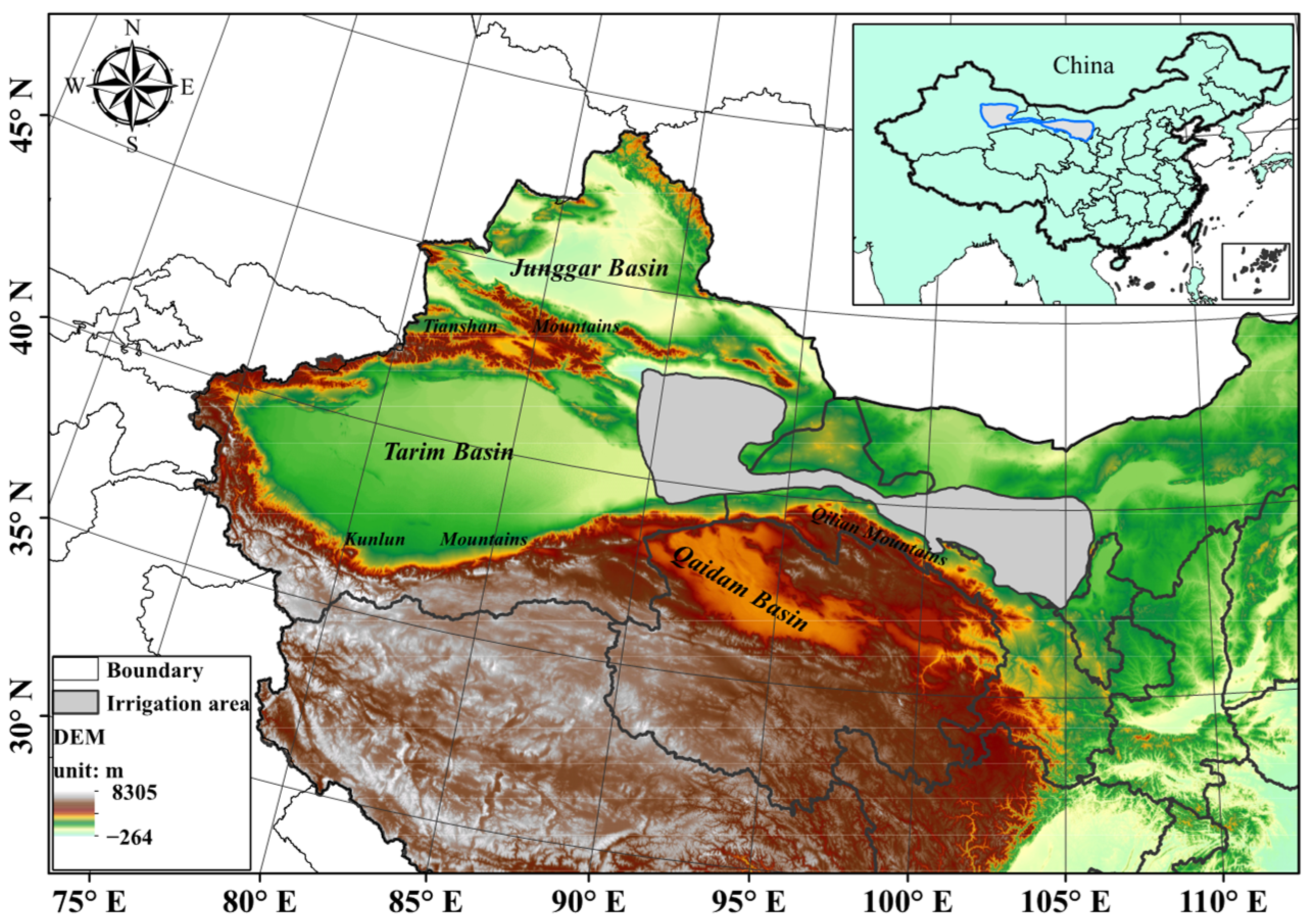
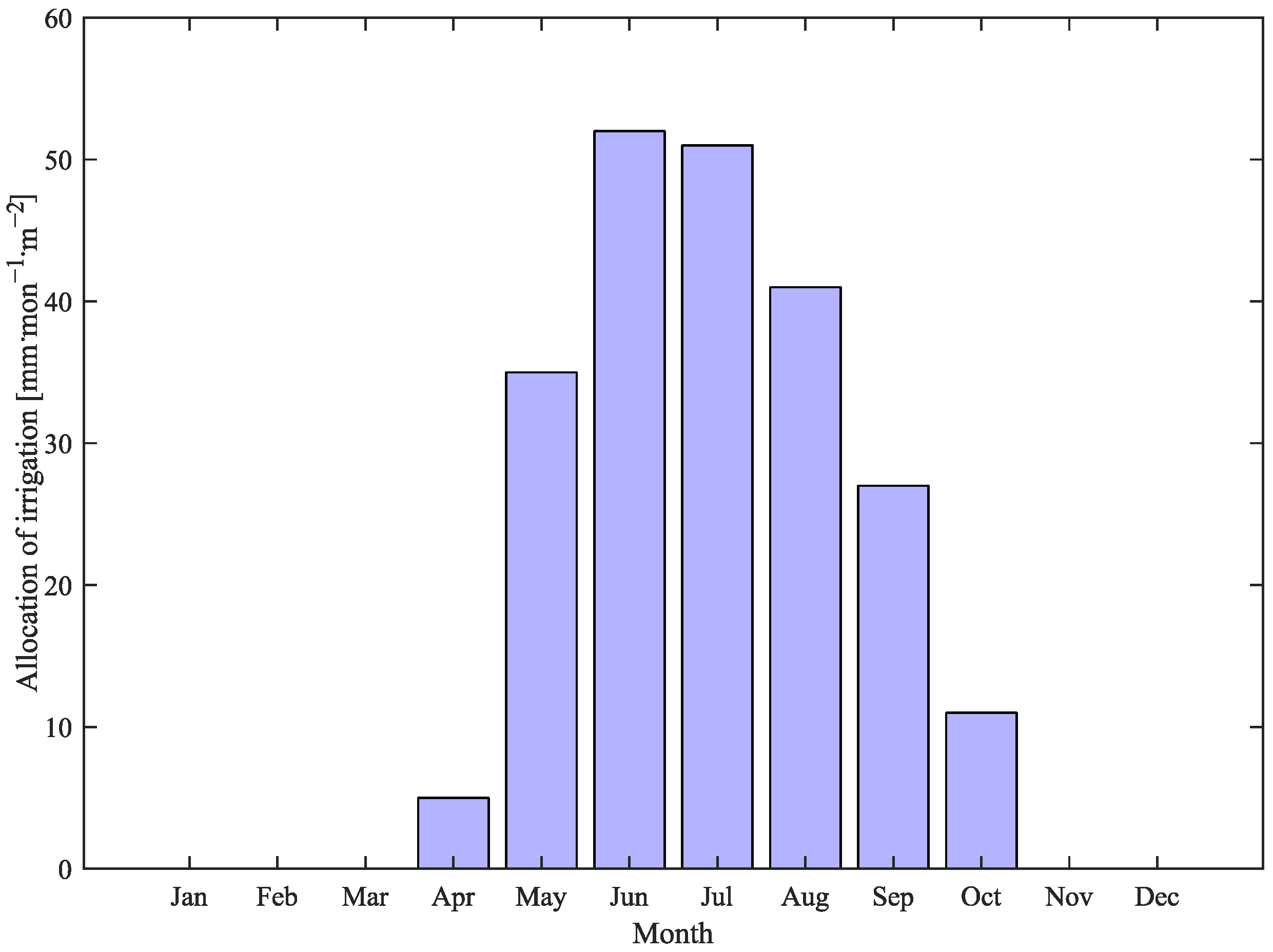
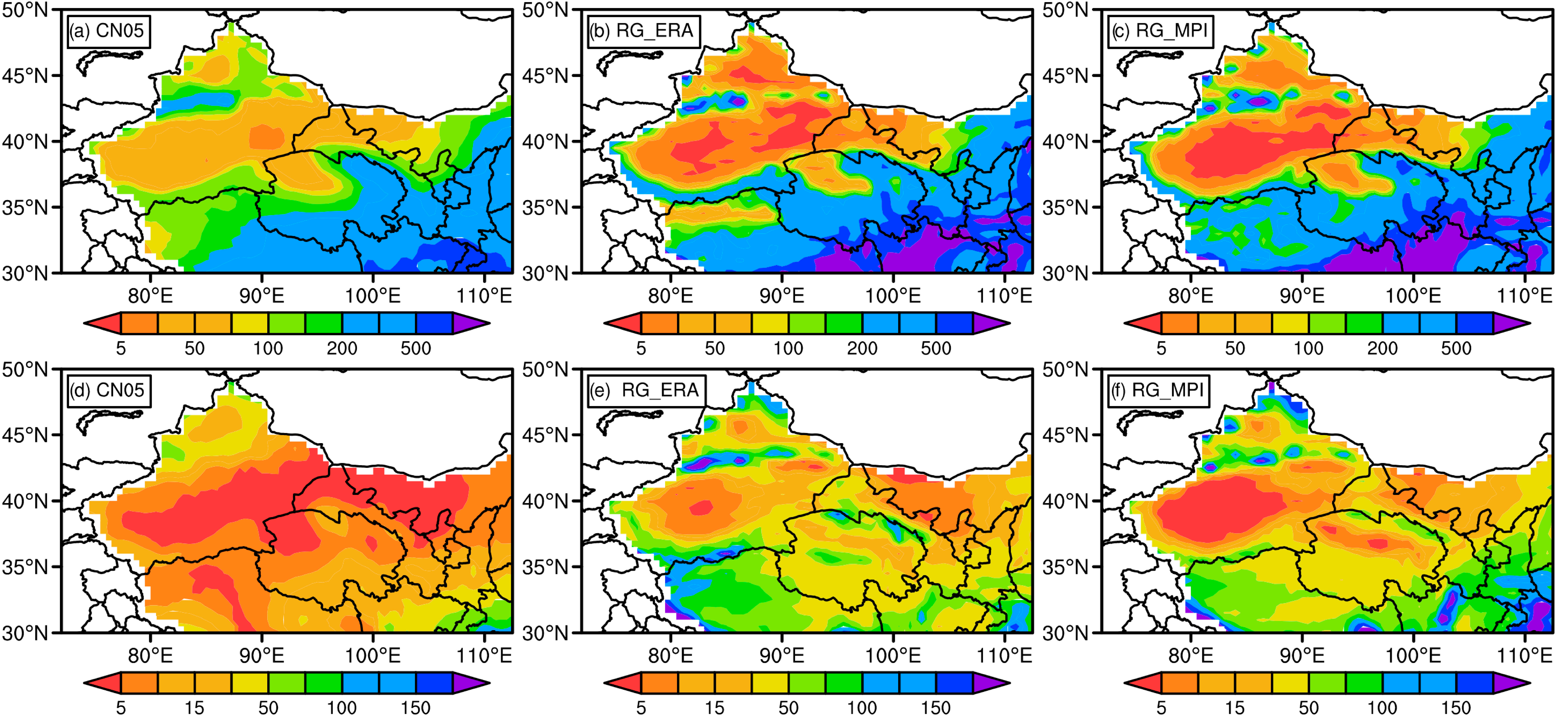
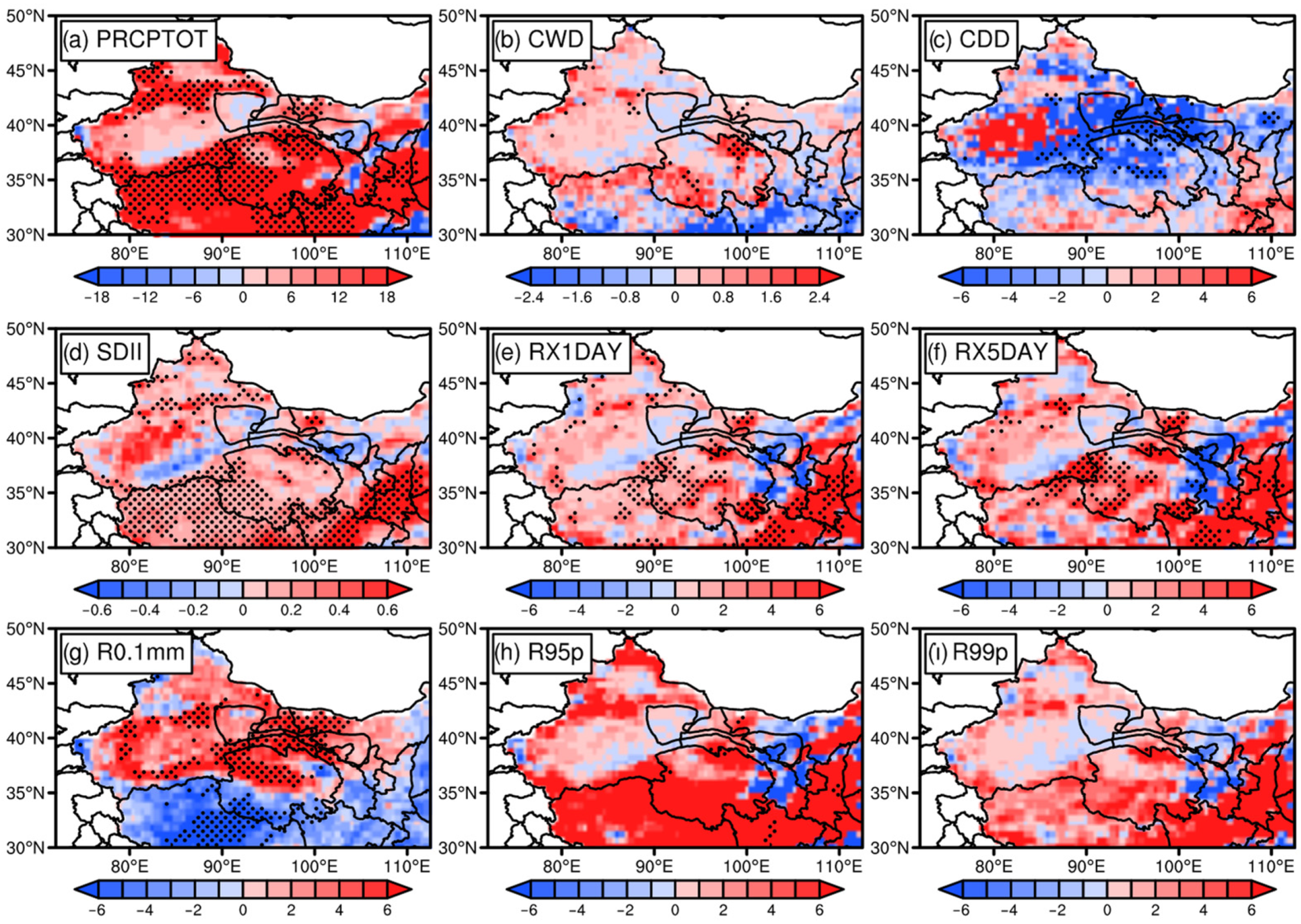
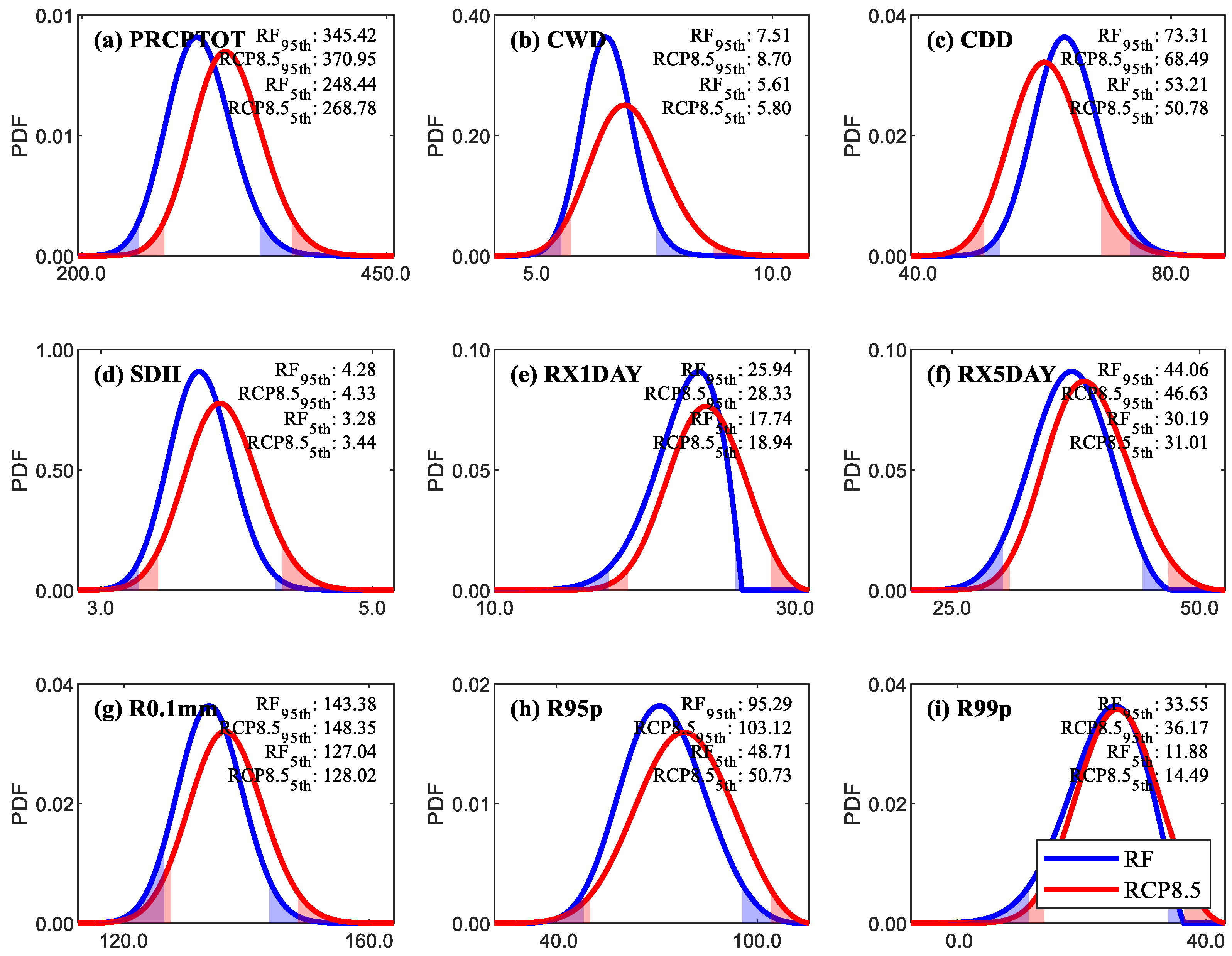
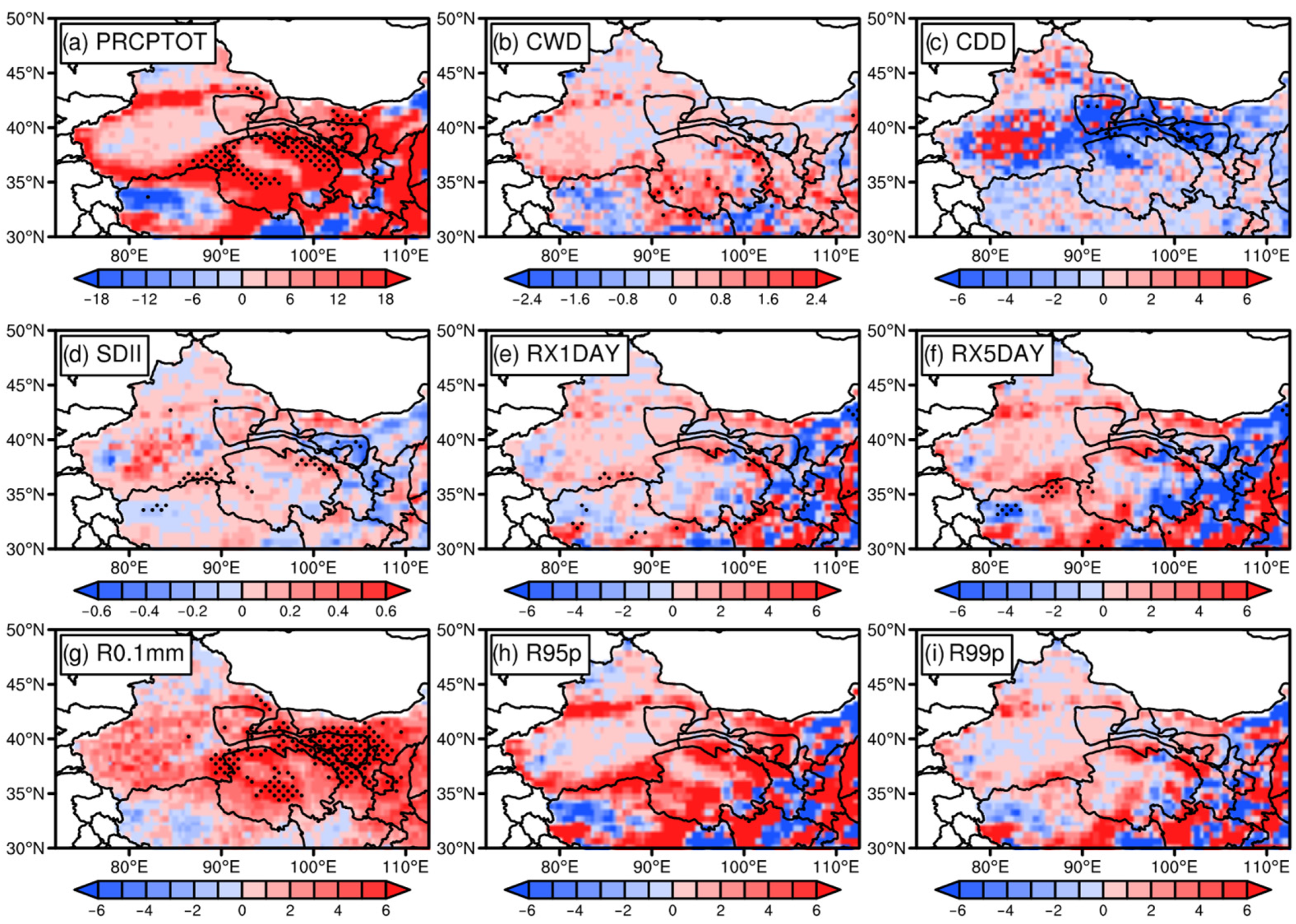
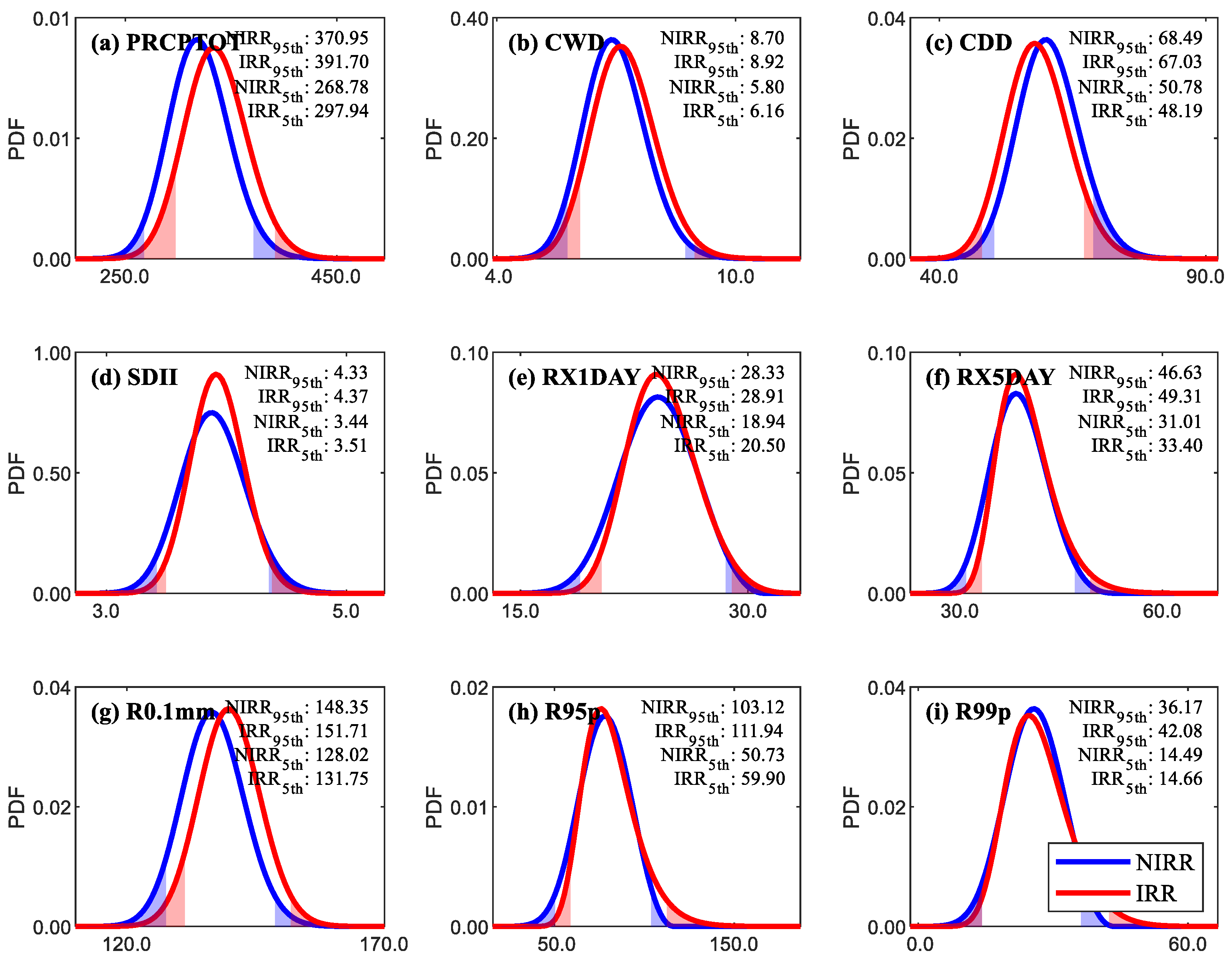
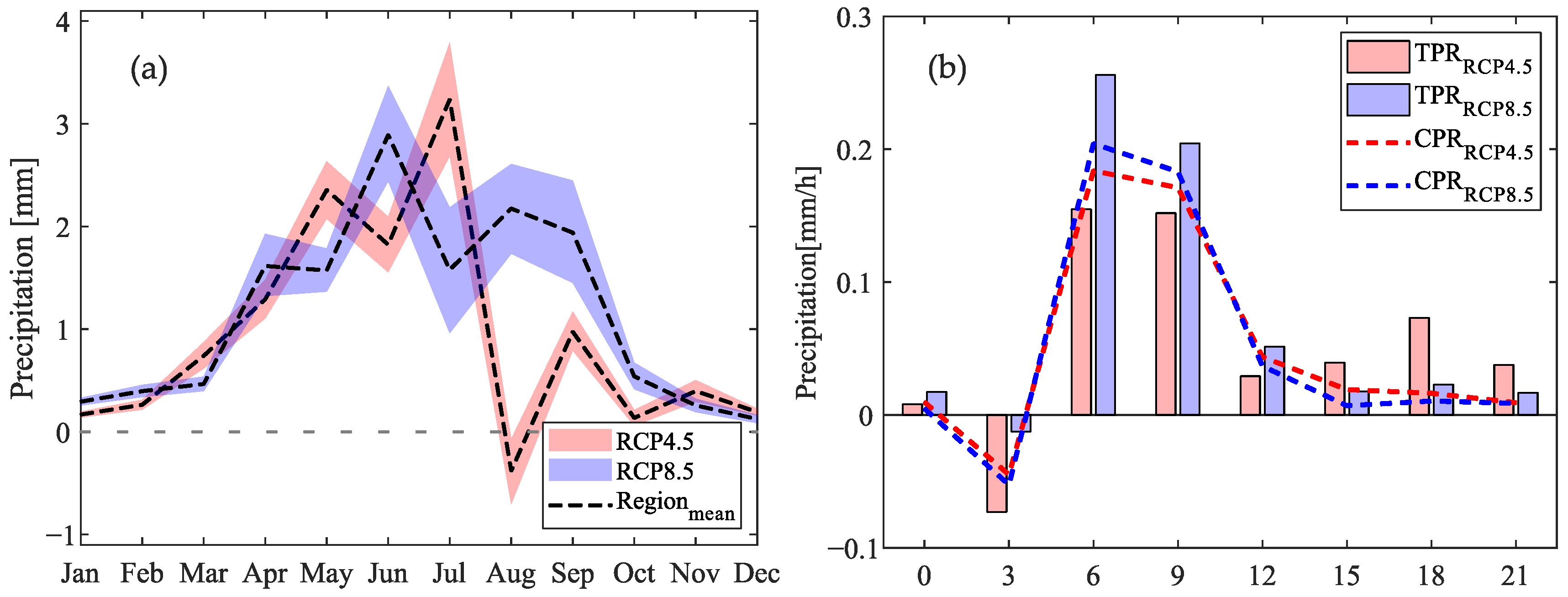
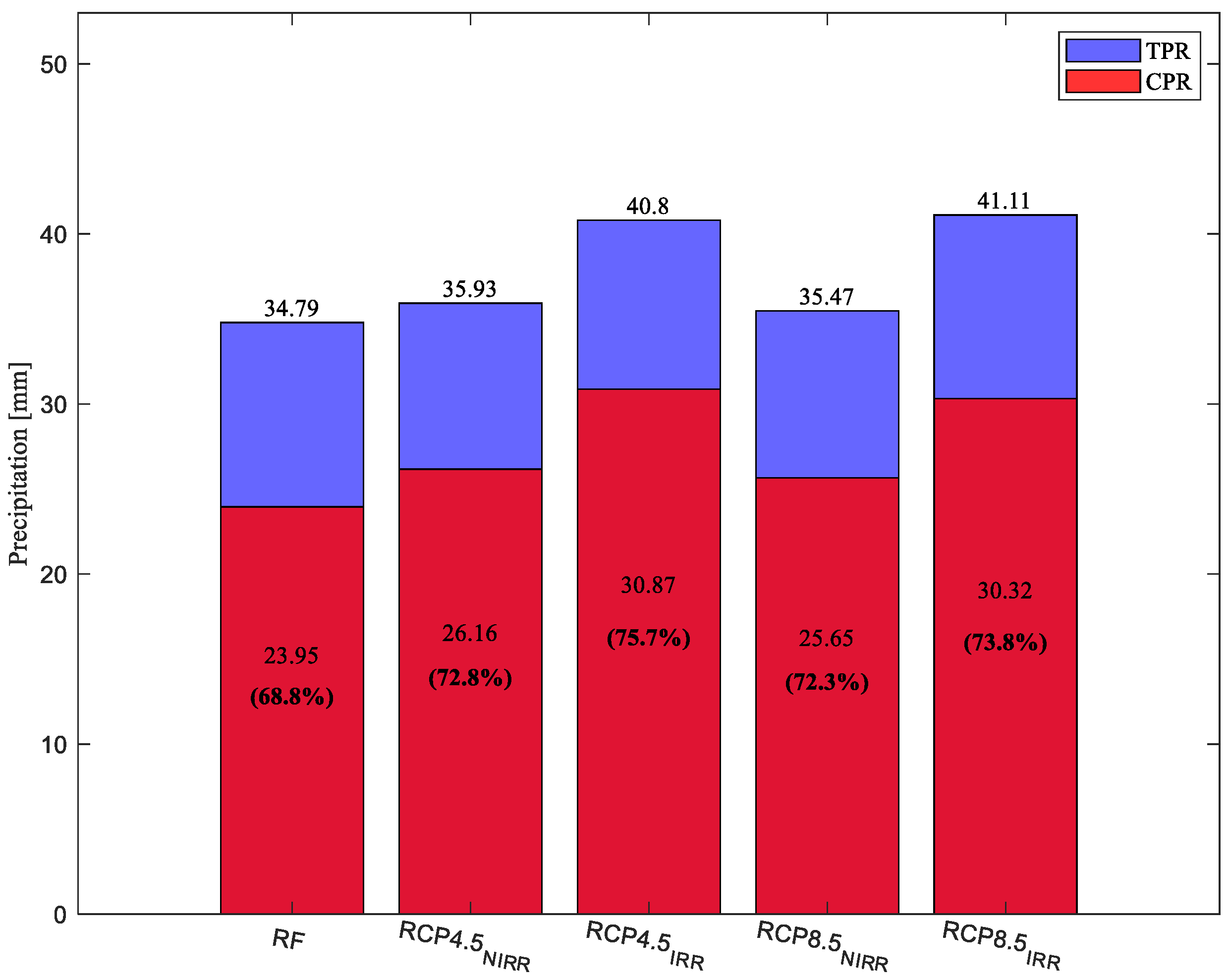

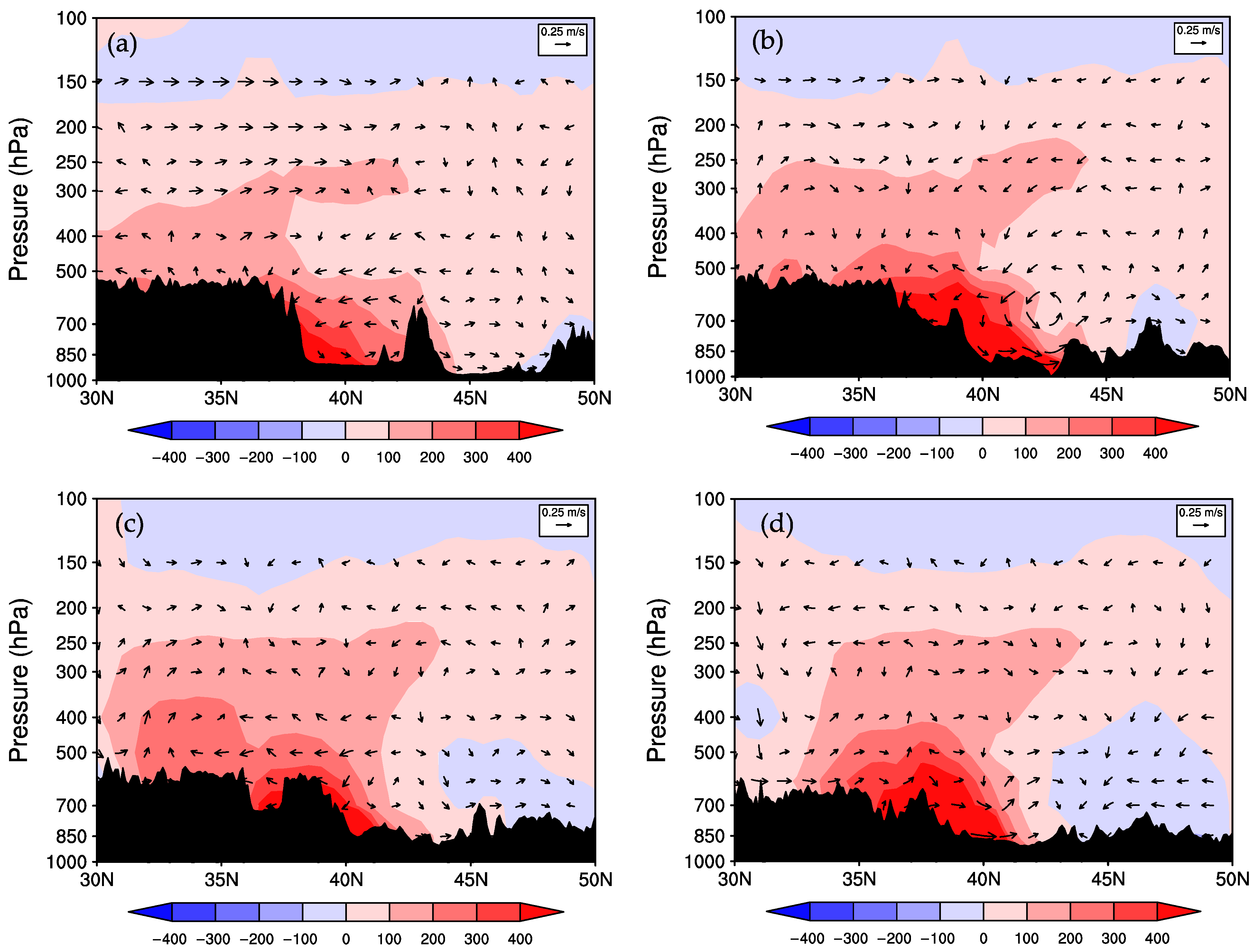
| No. | Initial and Lateral Boundary Conditions | LULC Types and Irrigation Scenarios |
|---|---|---|
| EXP_RF1 | ERA | Default LULC types (without irrigation) |
| EXP_RF2 | MPI-ESM-MR | Default LULC types (without irrigation) |
| EXP_NR45 | MPI-ESM-MR (RCP4.5) | Default LULC types (without irrigation) |
| EXP_YR45 | MPI-ESM-MR (RCP4.5) | Modified to cropland type (with 60 billion m3/year irrigation) |
| EXP_NR85 | MPI-ESM-MR (RCP8.5) | Default LULC types (without irrigation) |
| EXP_YR85 | MPI-ESM-MR (RCP8.5) | Modified to cropland type (with 60 billion m3/year irrigation) |
| Index | Descriptive Name | Definition | Units |
|---|---|---|---|
| PRCPTOT | Wet-day precipitation | Annual total precipitation based wet days | mm |
| SDII | Simple daily intensity index | Average precipitation on wet days | mm/day |
| RX1day | Maximum 1-day precipitation | Annual maximum 1-day precipitation | mm |
| RX5day | Maximum 5-day precipitation | Annual maximum 5-day precipitation | mm |
| R95 | Very wet day | Annual total precipitation when RR > 95th percentile | mm |
| R99 | Extreme very-wet day | Annual total precipitation when RR > 99th percentile | mm |
| CDD | Consecutive dry days | Maximum number of consecutive dry days | days |
| CWD | Consecutive wet days | Maximum number of consecutive wet days | days |
| R0.1 | Number of precipitation days | Annual count of days when RR ≥ 0.1 mm | days |
| Distribution | CDF | |
|---|---|---|
| GEV | ||
| Gumbel | ||
| Gamma | ||
| Exponential |
| Season | Data Source | Multiyear Average Precipitation (mm·day−1) | Correlation Coefficient |
|---|---|---|---|
| Summer | CN05 | 0.65 | |
| EXP_RF1 | 0.41 | 0.73 * | |
| EXP_RF2 | 0.49 | 0.76 * | |
| Winter | CN05 | 0.04 | |
| EXP_RF1 | 0.11 | 0.36 | |
| EXP_RF2 | 0.13 | 0.45 |
Disclaimer/Publisher’s Note: The statements, opinions and data contained in all publications are solely those of the individual author(s) and contributor(s) and not of MDPI and/or the editor(s). MDPI and/or the editor(s) disclaim responsibility for any injury to people or property resulting from any ideas, methods, instructions or products referred to in the content. |
© 2023 by the authors. Licensee MDPI, Basel, Switzerland. This article is an open access article distributed under the terms and conditions of the Creative Commons Attribution (CC BY) license (https://creativecommons.org/licenses/by/4.0/).
Share and Cite
Huang, Y.; Zhao, Y.; Gong, B.; Yang, J.; Li, Y. Effects of Potential Large-Scale Irrigation on Regional Precipitation in Northwest China. Remote Sens. 2024, 16, 58. https://doi.org/10.3390/rs16010058
Huang Y, Zhao Y, Gong B, Yang J, Li Y. Effects of Potential Large-Scale Irrigation on Regional Precipitation in Northwest China. Remote Sensing. 2024; 16(1):58. https://doi.org/10.3390/rs16010058
Chicago/Turabian StyleHuang, Ya, Yong Zhao, Boya Gong, Jing Yang, and Yanping Li. 2024. "Effects of Potential Large-Scale Irrigation on Regional Precipitation in Northwest China" Remote Sensing 16, no. 1: 58. https://doi.org/10.3390/rs16010058
APA StyleHuang, Y., Zhao, Y., Gong, B., Yang, J., & Li, Y. (2024). Effects of Potential Large-Scale Irrigation on Regional Precipitation in Northwest China. Remote Sensing, 16(1), 58. https://doi.org/10.3390/rs16010058







